Businesses in arts, entertainment and recreation sector
Data extracted in March 2024
Planned article update: April 2025
Highlights
Around 894 000 enterprises operated in the arts, entertainment and recreation sector, accounting for 2.9 % of the total number of enterprises active in the EU's business economy in 2021.
In 2021, businesses in the arts, entertainment and recreation sector generated €86.5 billion of value added and €209.8 billion of net turnover.
This article presents an overview of statistics for the European Union's (EU) arts, entertainment and recreation sector, as covered by NACE Rev. 2 Section R. It belongs to a set of statistical articles on 'Business economy by sector'. Following the entry into force of the European Business Statistics (EBS) Regulation, Eurostat has extended the service coverage for structural business statistics (SBS) data and is publishing, for the first time, SBS data on the arts, entertainment and recreation sector. Additional information is also available from other data collections such as culture and sport.
Full article
Structural profile
In 2021, around 894 000 enterprises operated in the EU's arts, entertainment and recreation sector (Section R), with a share of 2.9 % of the total number of enterprises active in the business economy (Sections B to N and P to R, as well as Divisions S95 and S96). These enterprises employed 2.1 million persons, contributing to 1.3 % of the persons employed in the business economy in 2021. The arts, entertainment and recreation sector accumulated a net turnover of €209.8 billion in 2021 and generated €86.5 billion in value added, representing 0.9 % of the EU's business economy value added.
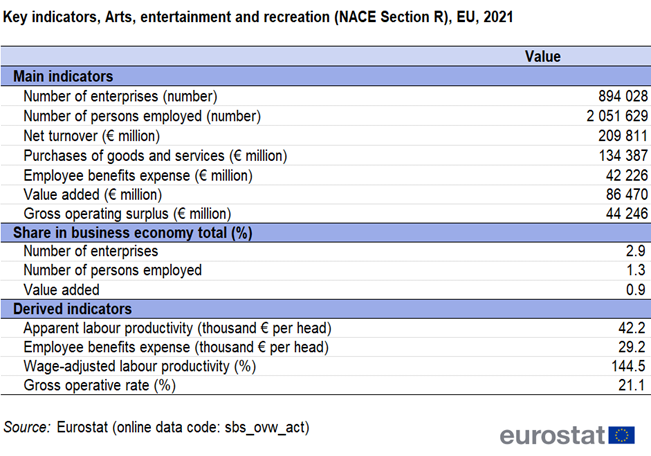
Source: Eurostat (sbs_ovw_act)
In 2021, the EU's arts, entertainment and recreation sector recorded apparent labour productivity and average employee benefits expense below the business economy averages. The apparent labour productivity in the arts, entertainment and recreation sector stood at €42 200 per person employed, representing a difference of €18 000 compared with the business economy average of €60 200 per person employed. Similarly, the average employee benefits expense within the arts, entertainment and recreation sector amounted to €29 200 per employee, indicating a difference of €9 800 from the business economy average of €39 000 per employee.
Combining these two ratios into the wage-adjusted labour productivity ratio shows the extent to which value added per person employed covers average personnel costs per employee. In 2021, the arts, entertainment and recreation sector demonstrated a wage-adjusted labor productivity ratio of 144.5 %, a ratio close to the business economy average of 154.4 %. The gross operating rate, which indicates the share of turnover remaining after paying for purchased goods and services as well as employee benefits expense (in other words, the gross operating surplus) stood at 21.1 % for the EU's arts, entertainment and recreation sector in 2021. This figure surpassed the 13.2 % average of gross operating rate for the business economy.
Sectoral analysis
The arts, entertainment and recreation sector is organised into five NACE divisions at two digits level: creative, arts and entertainment activities (Division 90.0), libraries, archives, museums and other cultural activities (Division 91.0), gambling and betting activities (Division 92.0), sports activities (Division 93.1) and amusement and recreation activities (Division 93.2).
In 2021, more than a third of the EU's employment in the arts, entertainment and recreation sector were allocated to the subsector of sports activities, which includes the operation of sports facilities and activities of sports teams or clubs, like football, hockey, cricket, rugby stadiums, swimming pools and winter sport arenas and stadiums, among others - see Figure 1. This subsector comprised 181 800 enterprises and a workforce of 730.9 million persons, contributing to the EU's business economy with a value added of €24.9 billion, representing almost 30 % of the whole sector's value added.
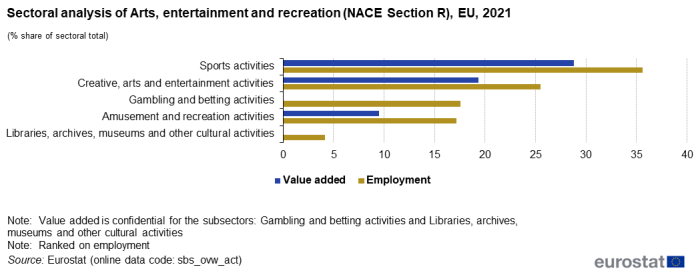
(% share of sectoral total)
Source: Eurostat (sbs_ovw_act)
The second highest share in the sector of arts, entertainment and recreation sector was recorded in the subsector of creative, arts and entertainment activities, which covers operation of arts facilities, production of live theatrical presentations, concerts, opera and dance productions, as well as activities of individual artists such as sculptors, painters, individual writers and independent journalists. The subsector of creative, arts and entertainment activities employed a quarter of the sector's workforce in 2021 and registered the highest number of enterprises, 521 000. In 2021, these enterprises generated a value added of €16.7 billion and a net turnover of €29.4 billion.
The highest net turnover among the available data was recorded in the subsector of gambling and betting activities (€110 billion), which includes the operation of casinos, bingo halls, video gaming terminals and the sale of lottery tickets. Despite the high turnover, a relatively low number of enterprises operated in this subsector (38 200 enterprises). Together they employed 360 000 persons, counting for 17.5 % of the sector's employment. A similar share in employment was also recorded in the subsector of amusement and recreational activities, which comprises activities of amusement parks or theme parks. However, the 140 000 active enterprises active in 2021 in this subsector accumulated a much lower net turnover of only €48.4 billion. The smallest subsector, both in terms of number of enterprises and net turnover was the division of libraries, archives, museums and other cultural activities.

Source: Eurostat (sbs_ovw_act)
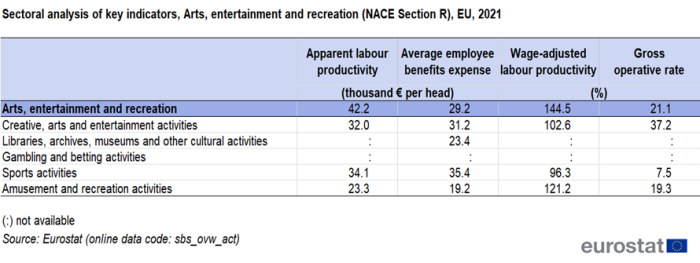
Source: Eurostat (sbs_ovw_act)
Country overview
Across EU countries, the SBS data on the arts, entertainment and recreation sector showed varying contributions to the value added of the business economy, with an average of 0.9 % at EU level - see Figure 2. In 2021, the shares varied from 0.2 % in Luxembourg, 0.4 % in Poland and 0.5 % in Ireland to 2.2 % in Spain, 2.3 % in Hungary and 3.7 % in Slovakia. Malta was an outlier reaching the highest share of value added (16.9 %), as well as the highest share of employment (5.3 %). In terms of employment, at the higher end of the scale, Denmark stood at 2.6 %, Spain at 2.3 % and the Netherlands at 2.2 %. At the lower end of the scale, with shares in employment lower than 1 %, were Czechia (0.8 %), Poland (0.5 %), and Luxembourg (0.4 %).
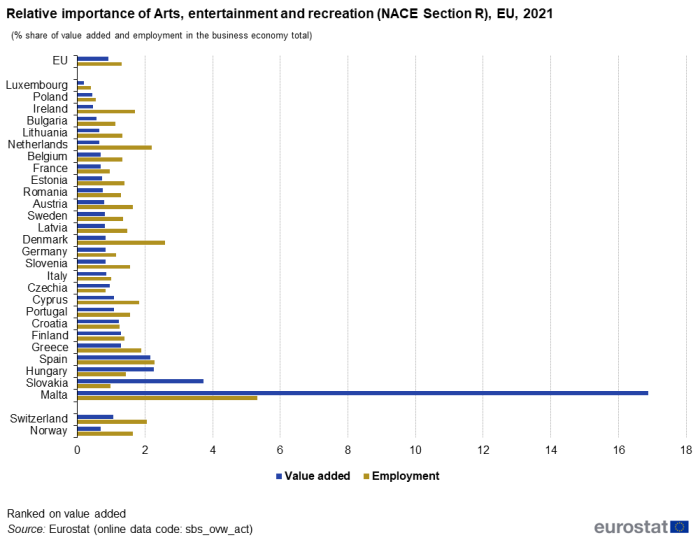
(% share of value added and employment in the business economy total)
Source: Eurostat (sbs_ovw_act)
The share of the value added of Division R92 'Gambling and betting activities' in NACE Section R 'Arts, entertainment and recreation' varied strongly among EU countries. The EU average was estimated around 38 %, with the lowest value in the Netherlands (11 %) and the highest in Malta (98 %). In Malta, gambling and betting activities generated over 16 % of the value added of the whole business economy, while in most EU countries (except Greece (1.0 %), Hungary (1.9 %) and Slovakia (3.6 %)) this share was below 1 %. This fact explains the exceptionally high share of the value added in NACE Section R in the total value added of Malta's business economy.
The contribution of the top five countries in the arts, entertainment and recreation sector accounted for 70.2 % of the value added and 64.6 % of employment. Among the five largest EU countries, Germany accounted for 26.8 % of the EU valued added of market activities in the arts, entertainment and recreation sector in 2021, slightly below its 29.3 % share of value added in the EU's business economy as a whole. Spain recorded the second-highest share, accounting for 16.7 % of the value added in the EU's arts, entertainment and recreation sector, surpassing its 7.2 % share in the business economy. France, Italy and the Netherlands recorded the following highest shares of value added. In terms of employment, the arts, entertainment and recreation sector had the highest share in the whole business economy in Germany (21.4 %), being followed by Spain, France, the Netherlands and Italy - see Figure 3.
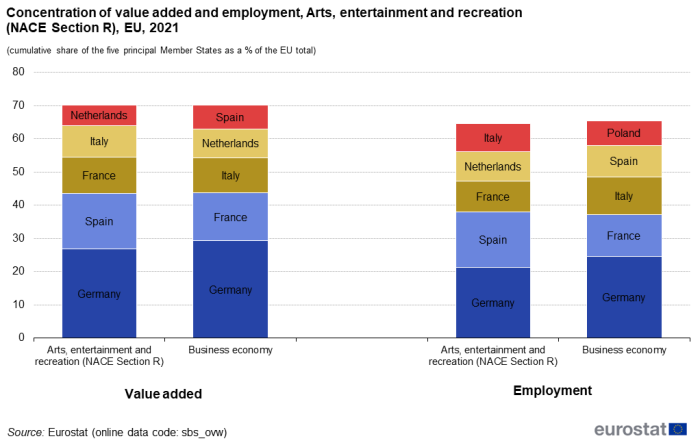
(cumulative share of the five principal countries as a % of the EU total)
Source: Eurostat (sbs_ovw_act)

Source: Eurostat (sbs_ovw_act)
In value added terms, in 2021, Germany was the largest EU country in all five subsectors of the arts, entertainment and recreation sector. However, in each subsector another EU country was the most specialised (see Table 3). As seen in Table 4, in absolute terms, Spain recorded the highest level of turnover (€38.5 billion) within the arts, entertainment and recreation sector in 2021. The second and third highest values in net turnover for the arts, entertainment and recreation sector were recorded in Germany (€34.6 billion), France (€24.5 billion) and Italy (€23.4 billion). The same four countries also dominated the employment, Germany recording the highest number of persons employed within the arts, entertainment and recreation sector in 2021, 0.4 million persons. Among the EU countries, Belgium recorded the highest level of average employee benefits expense within the arts, entertainment and recreation sector in 2021, €48 300 per employee. Above the EU average of €29 200 per employee, were situated also France, Luxembourg, Italy, Malta, Austria, Finland, Sweden, Spain and Ireland. On the other hand, average employee benefits expense were below €10 000 per employee in Romania, Bulgaria and Greece, where the lowest levels were recorded.
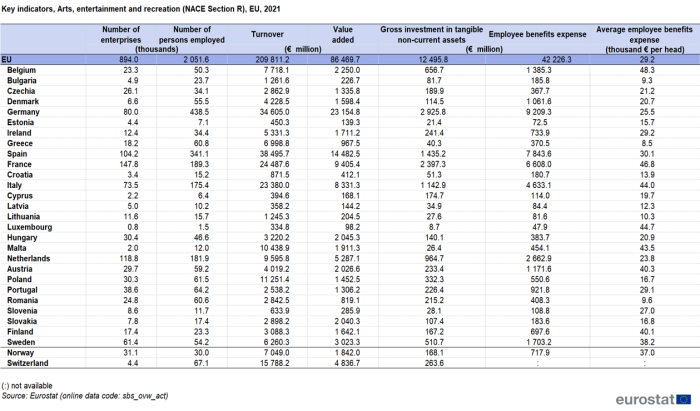
Source: Eurostat (sbs_ovw_act)
Source data for tables and graphs
Data sources and availability
Coverage
The arts, entertainment and recreation sector includes a wide range of activities to meet varied cultural, entertainment and recreational interests of the general public, including live performances, operation of museum sites, gambling, sports and recreation activities.
The activities covered by the arts, entertainment and recreation sector sector are categorised as follows:
- Creative, arts and entertainment activities (Division 90.0)
This division includes the operation of facilities and provision of services to meet the cultural and entertainment interests of their customers. This includes the production and promotion of, and participation in, live performances, events or exhibits intended for public viewing; the provision of artistic, creative or technical skills for the production of artistic products and live performances.
- Libraries, archives, museums and other cultural activities (Division 91.0)
This division includes the activities of libraries and archives; the operation of museums of all kinds, botanical and zoological gardens; the operation of historical sites and nature reserves activities. It also includes the preservation and exhibition of objects, sites and natural wonders of historical, cultural or educational interest (e.g. world heritage sites, etc.)
- Gambling and betting activities (Division 92.0)
This division includes the operation of gambling facilities such as casinos, bingo halls and video gaming terminals and the provision of gambling services, such as lotteries and off-track betting.
- Sports activities and amusement and recreation activities (Division 93)
- Sports activities (Division 93.1)
This group includes the operation of sports facilities; activities of sports teams or clubs primarily participating in live sports events before a paying audience; independent athletes engaged in participating in live sporting or racing events before a paying audience; owners of racing participants such as cars, dogs, horses, etc. primarily engaged in entering them in racing events or other spectator sports events; sports trainers providing specialised services to support participants in sports events or competitions; operators of arenas and stadiums; other activities of organising, promoting or managing sports events, n.e.c.
- Amusement and recreation activities (Division 93.2)
This group includes a wide range of units that operate facilities or provide services to meet the varied recreational interests of their patrons. It includes the operation of a variety of attractions, such as mechanical rides, water rides, games, shows, theme exhibits and picnic grounds. This group excludes sports activities and dramatic arts, music and other arts and entertainment.
Data sources
Structural business statistics cover the 'business economy', which includes industry, construction and many services (NACE Rev. 2 sections B to N, P to R as well as division S95 and S96). Structural business statistics do not cover agriculture, forestry and fishing, nor public administration.
Structural business statistics describe the business economy through the observation of units engaged in an economic activity; the unit in structural business statistics is generally the enterprise. An enterprise carries out one or more activities, at one or more locations, and it may comprise one or more legal units. Enterprises that are active in more than one economic activity (plus the value added and turnover they generate, the people they employ, and so on) are classified under the NACE heading corresponding to their principal activity; this is normally the one which generates the largest amount of value added.
The analysis presented in this article is based on the main dataset for structural business statistics (SBS), size class data and regional data, all of which are published annually. SBS only cover the activities of market producers, meaning those acting under market conditions. Contrary to most activities covered by SBS, non-market producers represent a significant part of the arts, entertainment and recreation sector.
The main series provides information for each EU Member State as well as a number of non-EU member countries at a detailed level according to the activity classification NACE. Data are available for a wide range of variables.
In structural business statistics, size classes are generally defined by the number of persons employed. A limited set of the standard structural business statistics variables (for example, the number of enterprises, turnover, persons employed and value added) are analysed by size class, mostly down to the three-digit (group) level of NACE. The main size classes used in this article for presenting the results are:
- small and medium-sized enterprises (SMEs): with 1 to 249 persons employed, further divided into
- micro enterprises: with less than 10 persons employed;
- small enterprises: with 10 to 49 persons employed;
- medium-sized enterprises: with 50 to 249 persons employed;
- large enterprises: with 250 or more persons employed.
Structural business statistics also include regional data. Regional SBS data are available at NUTS levels 1 and 2 for most of the EU Member States, Iceland and Norway, mostly down to the two-digit (division) level of NACE. The main variable analysed in this article is the number of persons employed. The type of statistical unit used for regional SBS data is normally the local unit, which is an enterprise or part of an enterprise situated in a geographically identified place. Local units are classified into sectors (by NACE) normally according to their own main activity, but in some EU Member States the activity code is assigned on the basis of the principal activity of the enterprise to which the local unit belongs. The main SBS data series are presented at national level only, and for this national data the statistical unit is the enterprise. It is possible for the principal activity of a local unit to differ from that of the enterprise to which it belongs. Hence, national SBS data from the main series are not necessarily directly comparable with national aggregates compiled from regional SBS.
Direct access to
- Recent Eurostat publications on SBS
- Key figures on Europe – 2023 edition – see subchapter on Business
- Eurostat's Regional Yearbook – see chapter 8. Business
- News Release SBS – 2021 final data
Glossary
ESMS metadata files
- Structural business statistics – SBS metadata file
- European Commission — Culture and Creativity
- European Commission — Data on the cultural sector
- European Commission — Culture and creative sectors
- European Commission — Creative Europe
- DG Education and Culture — Sport policy and programmes
- Erasmus+ Sport
- Special Eurobarometer — Sport and physical activity
- European Commission — Internal market, industry, entrepreneurship and SMEs